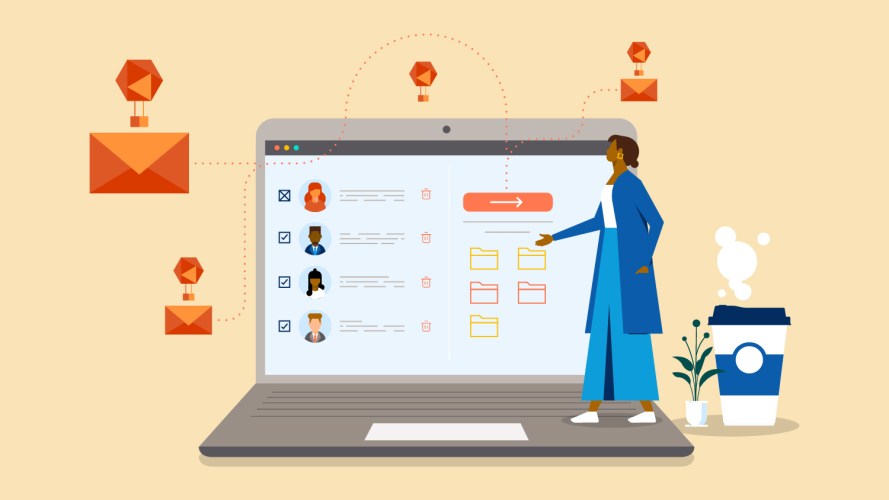3 Ways Generative AI Will Help Marketers Connect With Customers
3 min read


If you build it, they will come. That famous quote from Field of Dreams refers to a baseball field for ghosts, but can it also be applied to an email list? It sure can.
According to our research, email remains the best way to connect with customers. A good email list brings in new prospects, increases engagement with your community, and provides you with valuable customer and performance data to keep refining your efforts. However, building a strong list takes a smart strategy, the right tools and good execution.
Let’s break down the basics of email list building: why you should be doing it and how to get started.
How do you get readers to click and read your emails? The answer is easy if you take it logically, with these best practices.



Your email list is the email addresses you’ve collected through your website, blog, or social media campaigns. The people on your list have opted in, which means they decided they want to hear more from you via email. Your email list will allow you to send targeted messages with promotional and informative messages to subscribers.
Email lists are great because when people choose to sign up for content, it means they’re already interested in your brand. The fact that you have direct access to a list of good prospects helps you get your content right into their inbox – and since the prospects gave you permission to send them email, a trust factor is already built in. You can get started right away by sharing the value of your products or services.
Most marketers use email lists, so you need to have a good one to compete. With access to email addresses, you can segment your audiences and create personalized experiences that make your prospects feel special. A simple way to do this is adding your subscriber’s name to the subject line, along with content relative to their preferences.
So if your email list has the potential to engage subscribers, how do you keep them coming back for more? Repeat after me: Connection, connection, connection. Personalization really is the magic of email lists, and the power of crafting each message for individuals can’t be overstated.
Think of the last time you bought something you loved. What happened next? I hope you received subsequent emails that felt thoughtful, at a respectful frequency and with content that was relevant to you. Emails that consistently bring value create lasting bonds.
With email lists, you have the advantage of first-party data, which comes directly from your customers who have consented to you having it. With it, information like shopping preferences, demographics, and browsing behaviors are all at your fingertips.
When you get a view of a subscriber’s past purchases, you can tailor content and create more precise messaging. Using the first-party interactions from your email lists is a great way to gather insights and tailor messaging – and strengthen relationships. The better the first-party data, the better you can define your audience segments.
When your marketing platform features real-time personalization, it’s basically a personal assistant. The right platform can help you deliver messaging tailored to your audience, based on their behavior, as well as automating list creation. If someone’s been eyeing an item or left your website without checking out, it can send a follow up email.
You can create personalized email campaigns with dynamic content adapted according to set criteria such as user preferences, access times, or user locations. When a reader gets an email that doesn’t feel generic, but reaches them at the right time, we’ve found they’re more willing to take action.
For example, a travel company can personalize emails by incorporating relevant content that highlights destination suggestions aligned with the recipient’s travel preferences or previous bookings. This type of customization goes beyond generic messaging — and gives recipients more reason to open your future emails.
Your email lists can help you go from simple sends to multi-step journeys that include touchpoints like mobile and advertising based on how your list recipients are engaging. You can even use AI to help you automate it. A welcome email sequence, for example, can be scheduled to greet new subscribers, upping your chances at a good first impression.
Once you have your greeting in place, you can set up delivery time for subsequent emails and targeted content, guiding leads through your specific sales funnel. The communication is constant and at scale; in addition to this, you get time back for other business innovations when you don’t have to manually send emails.
The first mistake is not understanding the market and its rules.
Regulations such as the CAN-SPAM Act in the U.S. or the GDPR in the European Union dictate rules for obtaining consent, providing opt-out options, and safeguarding user data. Failure to comply can result in severe penalties, damage brand reputation, and lead to email deliverability issues as internet service providers actively filter out non-compliant emails. Be ethical about compliance and you are promoting customer trust and best email marketing practices.
Transparency about opting-in (or out) adds value because the communication between you and the recipient is consensual. Abide by this and you’ve already promoted a positive user experience and established your sender’s reputation. You minimize the risk of spam complaints, which protects you and your audience.
Second, there are plenty of ways to build your email list, but buying it is not one of them. While it seems like a quick and easy solution, it isn’t practical. Most people on paid email lists aren’t interested in whatever product or advice is being sent their way. Paid email lists end up in people’s spam folders, or they’ll unsubscribe – and feel mad about it. Save your business money by focusing on organic ways to build your email list.
So what does building an email list organically mean? For one, start with compelling opt-in forms or landing pages that have clear messaging, appealing design, and a user-friendly interface.
Opt-in forms should be easy to fill out, and clearly communicate the value of subscribing. For instance, a well-designed opt-in form for a fashion retailer may include fields for the subscriber’s name and email, accompanied by a visually appealing image showcasing the latest collection with a really great call-to-action.
Landing pages where people are directed after clicking the opt-in should align with the opt-in promise. For example, if the opt-in form promises exclusive discounts, the landing page should reiterate this offer and guide people on how to redeem it.
So how else can you connect with your audience and turn potential prospects into email subscribers? Demand generation is all about increasing your visibility – nobody can buy from your brand if they don’t know it exists, right? You can build awareness and grow your list with your content marketing, thought leadership, and social media content.
Suppose you run a fitness blog. You can use social media platforms like Instagram and Facebook to share engaging workout videos, nutrition tips, and success stories. Encourage your audience to subscribe to your newsletter for weekly workout plans and exclusive healthy recipes. At the same time, you can offer an ebook on “30 Days to a Healthier You,” as a free download to those who sign up for your email list. Share snippets of the ebook on social media to generate interest and drive traffic to your sign-up page.
Offering high-quality free content or gated assets in exchange for customers volunteering their information is a great way to get subscribers.
You want your lists streamlined so that communication is effective. Customer relationship management (CRM) is a system that helps you store customer information and track communication history. It can also analyze email campaign performance.
A CRM is an invaluable tool for building and maintaining an email list. CRM segmentation features enable you to categorize your audience based on various criteria. For instance, you can create segments for active customers, lapsed customers, or those who opened a recent email. This segmentation allows you to send targeted campaigns re-engaging inactive subscribers with a special offer or rewarding loyal customers with exclusive content.
CRM systems maintain a detailed history of interactions, including when your customer emailed, bought something, or made an inquiry. This historical data helps you understand customer preferences and behaviors. If a customer frequently engages with emails about fitness equipment but not with nutrition-related content, you can take this learning and tailor future emails.
A CRM can help you keep your email lists up-to-date. For example, when a customer’s details change, say if they get a new email address or job title, CRM systems make it easy to update this information centrally. If a subscriber updates their email address in a contact form on your website, the CRM can automatically sync this change, ensuring that your email list reflects the most recent and accurate data. This type of integration can help maintain compliance with opt-out requests, too.
There are a lot of platforms that allow you to easily set up automated welcome emails and follow-up sequences, ensuring new subscribers receive a series of engaging messages. These tools often offer lead magnet delivery automation, seamlessly delivering downloadable resources to subscribers upon sign-up, enhancing the overall user experience and incentivizing list growth.

3 min read

6 min read
Now that you’re ready to create a compliant email list with the help of CRM tools, how can you measure its success?
Some metrics to track your email list growth are simple; for example, how many new subscribers did you get in a month? How many did you expect to gain? By comparing the real data against your forecast, you’ll get a picture of what you’re working with.
Other email metrics include:
Conversion rate of sign-up forms: If your sign-up form received 500 views and 50 new subscribers, the conversion rate would be 10%. This reflects your form’s effectiveness.
Unsubscribe rate: If you sent 10,000 emails and 500 subscribers chose to unsubscribe, your unsubscribe rate is 5%. What does that tell you? How will you refine your strategy?
Bounce rate: If you sent 1,000 emails and 100 bounced, your bounce rate is 10%. This indicates the quality of your email list and potential issues with data accuracy.
Forward or share rate: If a promotional email is shared by 50 subscribers, it reflects the content’s appeal and can contribute to organic list growth as new recipients are exposed to your brand.
Engagement: Email click-through rate (CTR) is calculated by dividing the number of people who clicked on a link in your email by the total number of people who received the email. For example, if 1,000 people receive your email and 100 people click on a link, your email CTR would be 10%.
Having a great email list expands your reach and increases customer engagement and loyalty. You’ll have improved segmentation, deliverability, and conversion rates. Build it and they (the customers) will come? Yes – and it’ll help your team hit a home run with your marketing.
Want to grow and engage your audience through email? Check out the interactive elements available to you within Marketing Cloud and start sending emails your customers will love.




Get the latest articles in your inbox.


